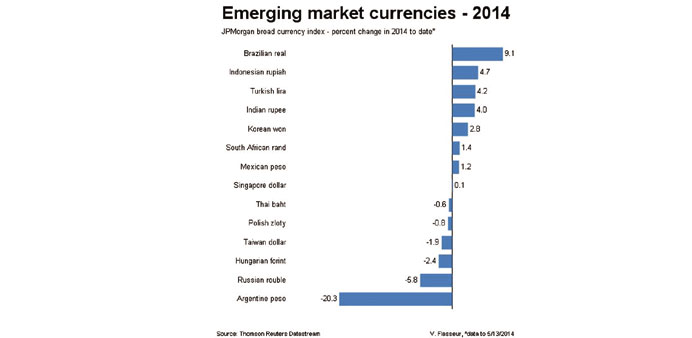Nations from Colombia to Indonesia are taking advantage of the longest emerging-market currencies rally since 2009 to pile up record reserves, bolstering their ability to fend off the next foreign-exchange crisis.
The 12 developing nations with the biggest foreign reserves outside of China added $34bn in the past three months, lifting their combined holdings to $2.98tn on April 30, the most since Bloomberg began compiling the data in 2008. A gauge of 20 emerging-market currencies is recovering after tumbling in February to the lowest level since April 2009.
“It makes sense to make hay while the sun’s shining, as they may have used up some reserves,” Clyde Wardle, a strategist at HSBC Holdings Plc, said in a phone interview from New York on May 8.
Emerging-market reserves were depleted by $22bn in January alone as nations fended off currency speculators to tackle the fallout from the Federal Reserve cutting bond-buying and global political and financial instability. Since then, the currencies gauge has rallied 5% from the February low, with policy makers now buying dollars to temper the gains, which make exports more expensive, while giving themselves more resources to help curb selloffs in the future.
Bloomberg’s index of 20 major emerging-market currencies fell 3% in January in the worst start to a year since 2009, in a rout sparked by events ranging from the Fed’s decision to start pulling back on stimulus to a slowdown in Chinese manufacturing and the devaluation of Argentina’s peso. Turkey and South Africa sought to stem a run on their currencies by raising interest rates.
Of the dozen biggest reserve holders among developing economies, India, Indonesia and Turkey boosted their holdings the most as government efforts to tame volatility and narrow current-account deficits succeeded in luring back overseas investors. “Some countries where reserves seemed to be under pressure, like India and Indonesia, have recovered,” Alan Ruskin, the global head of Group-of-10 foreign exchange at Deutsche Bank AG in New York, said in a May 7 phone interview.
India’s coffers expanded 7.6% since the end of January through yesterday to $285bn after touching a three-year low of $247bn in September. Indonesia’s reserves gained 4.9% and Turkey’s rose 4.1%. The reserve pools have expanded as global investors returned to buying the nations’ assets. Foreigners hold record amount of Indonesian local-currency bonds, while they increased their Indian holdings by 21% this year, spurring a 6% surge in the rupiah versus the US currency and a 4% rise in the rupee.
Net overseas purchases of Turkish debt were $697mn this quarter, trimming net selling this year to $2.9bn. The lira has climbed 3.3% versus the dollar in 2014.
China, not included in the reserves index because its size would skew results, boosted foreign reserves by $126.8bn in the first quarter to a record $3.95tn. Russia has been an exception among developing economies, depleting its reserves to stem losses in the rouble triggered by the country’s escalating conflict with neighbouring Ukraine. Bank Rossii sold $24.7bn and €2.5bn ($3.4bn) in the past two months as international sanctions against officials including President Vladimir Putin prompted investors to pull money from Russia.
The rouble has weakened 5.4% this year against the dollar, the worst performance after Argentina’s peso among 24 emerging-markets currencies tracked by Bloomberg.
“For the medium term, reserve depletion is an important risk to watch,” Jacob Nell, a London-based economist at Morgan Stanley, said in an e-mail on May 12.
For countries that rely on exports for economic growth, building reserves helps temper currency gains to maintain competitiveness in global markets.
Colombia saw reserves rise 0.7% in March to $41.8bn, the biggest increase since September, as the peso’s almost 5% advance over the past three months allowed it to buy the US currency more cheaply. It’s the fourth best- performer among developing currencies during that period, data compiled by Bloomberg show.
The finance ministry of the Andean nation, which exports coal, oil, and coffee, will restart dollar purchases as a competitive exchange rate is “for the benefit of the country,” minister Mauricio Cardenas said on Twitter yesterday.
In South Korea, where exports account for about half of the $1tn economy, foreign-currency reserves climbed to a record $354bn by the end of March as the central bank said it would move to stabilize the currency if necessary. The won has strengthened 2.5 this year.
“A very-appreciated currency will in the short term reduce the competitiveness of the local economy - it’s a logical move to try and take the most of the inflows by adding to international reserves,” Gabriel Gersztein, head of Latam currency strategy at BNP Paribas SA in Sao Paulo, said May 7. “A country with a high level of reserves is a country that’s better prepared to weather any kind of financial crisis.”



